A Case Study of Polar Cap Sporadic-E Layer Associated with TEC Variations
Abstract
1. Introduction
2. Instruments and Data Sets
3. Results
3.1. Solar Wind and IMF Conditions and Geomagnetic Indices
3.2. The Characteristics of Polar Cap Es Layer
3.3. TEC Variations
4. Discussions and Conclusions
Author Contributions
Funding
Data Availability Statement
Acknowledgments
Conflicts of Interest
References
- Layzer, D. Theory of midlatitude Sporadic E. Radio Sci. 1975, 7, 385–388. [Google Scholar] [CrossRef]
- Narcisi, R.S. Composition studies of the lower thermosphere. In Physics of Upper Atmosphere; Royal Society: London, UK, 1971; pp. 12–59. [Google Scholar]
- Behnke, R.A.; Vickery, J.F. Radar evidence for Fe+ in a sporadic-E layer. Radio Sci. 1975, 10, 325–327. [Google Scholar] [CrossRef]
- Turunen, T.; Nygren, T.; Huuskonen, A.; Jalonen, L. Incoherent scatter studies of Sporadic-E using 300 m resolution. J. Atmos. Terr. Phys. 1988, 50, 277–287. [Google Scholar] [CrossRef]
- Shinagawa, H.; Miyoshi, Y.; Jin, H.; Fujiwara, H. Global distribution of neutral wind shear associated with sporadic E layers derived from GAIA. J. Geophys. Res. Space Phys. 2017, 122, 4450–4465. [Google Scholar] [CrossRef]
- Singer, W.; von Zahn, U.; Weiß, J. Diurnal and annual variations of meteor rates at the arctic circle. Atmos. Chem. Phys. 2004, 4, 1355–1363. [Google Scholar] [CrossRef]
- Janches, D.; Palo, S.E.; Lau, E.M.; Avery, S.K.; Avery, J.P.; de la Peña, S.; Makarov, N.A. Diurnal and seasonal variability of the meteoric flux at the South Pole measured with radars. Geophys. Res. Lett. 2004, 31, L20807. [Google Scholar] [CrossRef]
- Kumar, S.; Hanson, W.B. The morphology of metallic ions in the upper atmosphere. J. Geophys. Res. 1980, 85, 6783–6801. [Google Scholar] [CrossRef]
- Bristow, W.A.; Watkins, B.J. Incoherent scatter observations of thin ionization layers at Sondrestrom. J. Atmos. Terr. Phys. 1993, 55, 873–894. [Google Scholar] [CrossRef]
- Yuan, T.; Wang, J.; Cai, X.; Sojka, J.; Rice, D.; Oberheide, J.; Criddle, N. Investigation of the seasonal and local time variations of the high-altitude sporadic Na layer (Nas) formation and the associated midlatitude descending E layer (Es) in lower E region. J. Geophys. Res. Space Phys. 2014, 119, 5985–5999. [Google Scholar] [CrossRef]
- Cai, X.G.; Yuan, T.; Vincent Eccles, J.; Raizada, S. Investigation on the distinct nocturnal secondary sodium layer behavior above 95 km in winter and summer over Logan, UT (41.7°N, 112°W) and Arecibo Observatory, PR (18.3°N, 67°W). J. Geophys. Res. Space Phys. 2019, 124, 9610–9625. [Google Scholar] [CrossRef]
- Whitehead, J.D. The formation of the Sporadic-E layer in the temperate zones. J. Atmos. Terr. Phys. 1961, 20, 49–58. [Google Scholar] [CrossRef]
- Carrasco, A.J.; Batista, I.S.; Abdu, M.A. Simulation of the sporadic E layer response to prereversal associated evening vertical electric field enhancement near dip equator. J. Geophys. Res. 2007, 112, A06324. [Google Scholar] [CrossRef]
- Kelley, M.C. The Earth’s Ionosphere: Plasma Physics and Electrodynamics, 2nd ed.; Elsevier: Cambridge, MA, USA, 2009; pp. 312–335. [Google Scholar]
- Haldoupis, C. A tutorial review on sporadic E layers. In Aeronomy of the Earth’s Atmosphere and Ionosphere; Abdu, M.A., Pancheva, D., Eds.; IAGA Special Sopron Book Series 2; Springer Science+Business Media: Berlin, Germany, 2011. [Google Scholar] [CrossRef]
- Yeh, W.H.; Liu, J.Y.; Huang, C.Y.; Chen, S.P. Explanation of the Sporadic-E layer formation by comparing FORMOSAT-3/COSMIC data with meteor and wind shear information. J. Geophys. Res. Atmos. 2014, 119, 4568–4579. [Google Scholar] [CrossRef]
- Nygren, T.; Jalonen, L.; Oksman, J.; Turunen, T. The role of electric field and neutral wind direction in the formation of sporadic E-layers. J. Atmos. Terr. Phys. 1984, 46, 373–381. [Google Scholar] [CrossRef]
- Bristow, W.A.; Watkins, B.J. Numerical simulation of the formation of thin ionization layers at high latitudes. Geophys. Res. Lett. 1991, 18, 404–407. [Google Scholar] [CrossRef]
- Kirkwood, S.; Zhan, U.V. On the role of auroral electric fields in the formation of low altitude sporadic-E and sudden sodium layers. J. Atmos. Terr. Phys. 1991, 53, 389–407. [Google Scholar] [CrossRef]
- Bedey, D.F.; Watkins, B.J. Large-scale transport of metallic ions and the occurrence of thin ion layers in the polar ionosphere. J. Geophys. Res. 1997, 102, 9675–9681. [Google Scholar] [CrossRef]
- Kirkwood, S.; Collis, P. Gravity wave generation of simultaneous auroral sporadic-E layers and sudden neutral sodium layers. J. Atmos. Terr. Phys. 1989, 51, 259–269. [Google Scholar] [CrossRef]
- MacDougall, J.W.; Jayachandran, P.T.; Plane, J.M.C. Polar cap sporadic-E: Part1, observation. J. Atmos. Terr. Phys. 2000, 62, 1155–1167. [Google Scholar] [CrossRef]
- MacDougall, J.W.; Jayachandran, P.T.; Plane, J.M.C. Polar cap sporadic-E: Part2, modelling. J. Atmos. Terr. Phys. 2000, 62, 1169–1176. [Google Scholar] [CrossRef]
- Hines, C.O. Internal atmospheric gravity waves at ionospheric heights. Can. J. Phys. 1960, 38, 1441–1481. [Google Scholar] [CrossRef]
- Axford, W.I. The formation and vertical movement of dense ionized layers in the ionosphere due to neutral wind shears. J. Geophys. Res. 1963, 68, 769–779. [Google Scholar] [CrossRef]
- Fukao, S.; Yamamoto, M.; Tsunoda, R.T.; Hayakawa, H.; Mukai, T. The SEEK (Sporadic-E Experiment over Kyushu) Campaign. Geophys. Res. Lett. 1998, 25, 1761–1764. [Google Scholar] [CrossRef]
- Wu, D.L.; Ao, C.O.; Hajj, G.A.; de la Torre Juarez, M.; Mannucci, A.J. Sporadic E morphology from GPS CHAMP radio occultation. J. Geophys. Res. 2005, 110, A01306. [Google Scholar] [CrossRef]
- Larsen, M.F.; Hysell, D.L.; Zhou, Q.H.; Smith, S.M.; Friedman, J.; Bishop, R.L. Imaging coherent scatter radar, incoherent scatter radar, and optical observations of quasiperiodic structures associated with sporadic E layers. J. Geophys. Res. 2007, 112, A06321. [Google Scholar] [CrossRef]
- Maeda, J.; Heki, K. Two-dimensional observations of midlatitude sporadic E irregularities with a dense GPS array in Japan. Radio Sci. 2014, 49, 28–35. [Google Scholar] [CrossRef]
- Maeda, J.; Suzuki, T.; Furuya, M.; Heki, K. Imaging the midlatitude sporadic E plasma patches with a coordinated observation of spaceborne InSAR and GPS total electron content. Geophys. Res. Lett. 2016, 43, 1419–1425. [Google Scholar] [CrossRef]
- Sun, W.J.; Ning, B.Q.; Yue, X.A.; Li, G.Z.; Hu, L.H.; Chang, S.M.; Lan, J.P.; Zhu, Z.P.; Zhao, B.Q.; Lin, J. Strong sporadic E occurrence detected by ground-based GNSS. J. Geophys. Res. Space Phys. 2018, 123, 3050–3062. [Google Scholar] [CrossRef]
- Jayachandran, P.T.; Langley, R.B.; MacDougall, J.W.; Mushini, S.C.; Pokhotelov, D.; Hazma, A.M.; Mann, I.R.; Milling, D.K.; Kale, Z.C.; Chadwick, R.; et al. Canadian High Arctic Ionospheric Network (CHAIN). Radio Sci. 2009, 44, RS0A03. [Google Scholar] [CrossRef]
- Bahcivan, H.; Tsunoda, R.; Nicolls, M.; Heinselman, C. Initial ionospheric observations made by the new Resolute incoherent scatter radar and comparison to solar wind IMF. Geophys. Res. Lett. 2010, 37, L15103. [Google Scholar] [CrossRef]
- Haldoupis, C.; Meek, C.; Christakis, N.; Pancheva, D.; Bourdillon, A. Ionogram height-time-intensity observations of descending sporadic E layers at mid-latitude. J. Atmos. Sol. Terr. Phys. 2006, 68, 539–557. [Google Scholar] [CrossRef]
- Pignalberi, A.; Pezzopane, M.; Zuccheretti, E. Sporadic E layer at mid-latitudes: Average properties and influence of atmospheric tides. Ann. Geophys. 2014, 32, 1427–1440. [Google Scholar] [CrossRef]
- Mushini, S.C.; Jayachandran, P.T.; Langley, R.B.; MacDougall, J.W.; Pokhotelov, D. Improved amplitude- and phase-scintillation indices derived from wavelet detrended high-latitude GPS data. GPS Solut. 2012, 16, 363–373. [Google Scholar] [CrossRef]
- McCaffrey, A.M.; Jayachandran, P.T. Spectral characteristics of auroral region scintillation using 100 Hz sampling. GPS Solut. 2017. [Google Scholar] [CrossRef]
- McCaffrey, A.M.; Jayachandran, P.T. Determination of the refractive contribution to GPS phase “scintillation”. J. Geophys. Res. Space Phys. 2019, 124, 1454–1469. [Google Scholar] [CrossRef]
- Krankowaki, A.; Shagimuratov, I.I.; Baran, L.W.; Ephishov, I.I.; Tepenitzyna, N.J. The occurrence of polar cap patches in TEC fluctuations detected using GPS measurements in southern hemisphere. Adv. Space Res. 2006, 38, 2601–2609. [Google Scholar] [CrossRef]
- Zhang, Q.H.; Zong, Q.G.; Lockwood, M.; Heelis, R.A.; Hairston, M.; Liang, J.; McCrea, I.; Zhang, B.C.; Moen, J.; Zhang, S.R.; et al. Earth’s ion upflow associated with polar cap patches: Global and in situ observations. Geophys. Res. Lett. 2016, 43, 1845–1853. [Google Scholar] [CrossRef]
- Jin, Y.Q.; Moen, J.; Oksavik, K.; Spicher, A.; Clausen, B.N.; Miloch, W.J. GPS scintillations associated with cusp dynamics and polar cap patches. J. Space Weather Space Clim. 2017, 7, A23. [Google Scholar] [CrossRef]
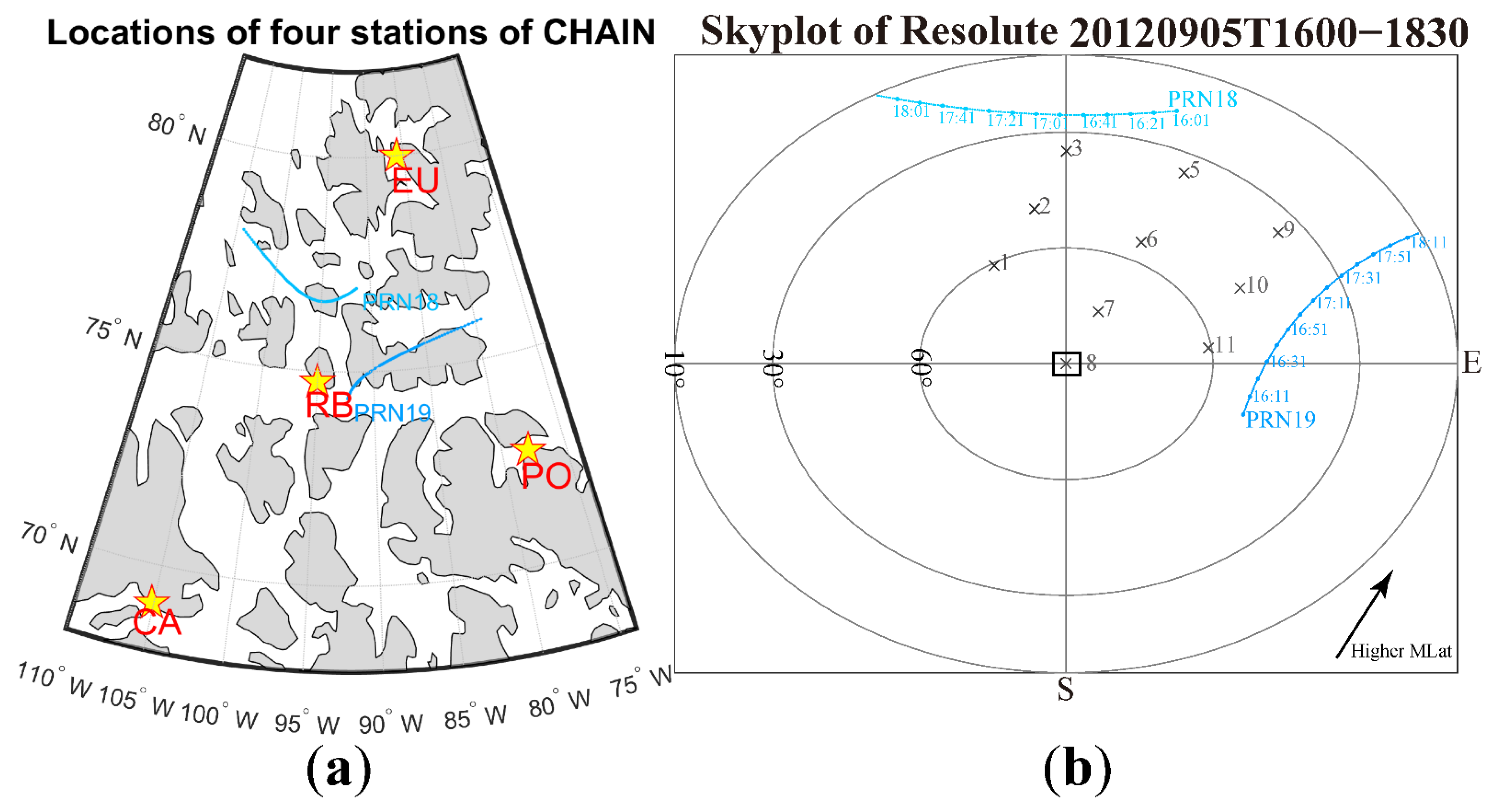
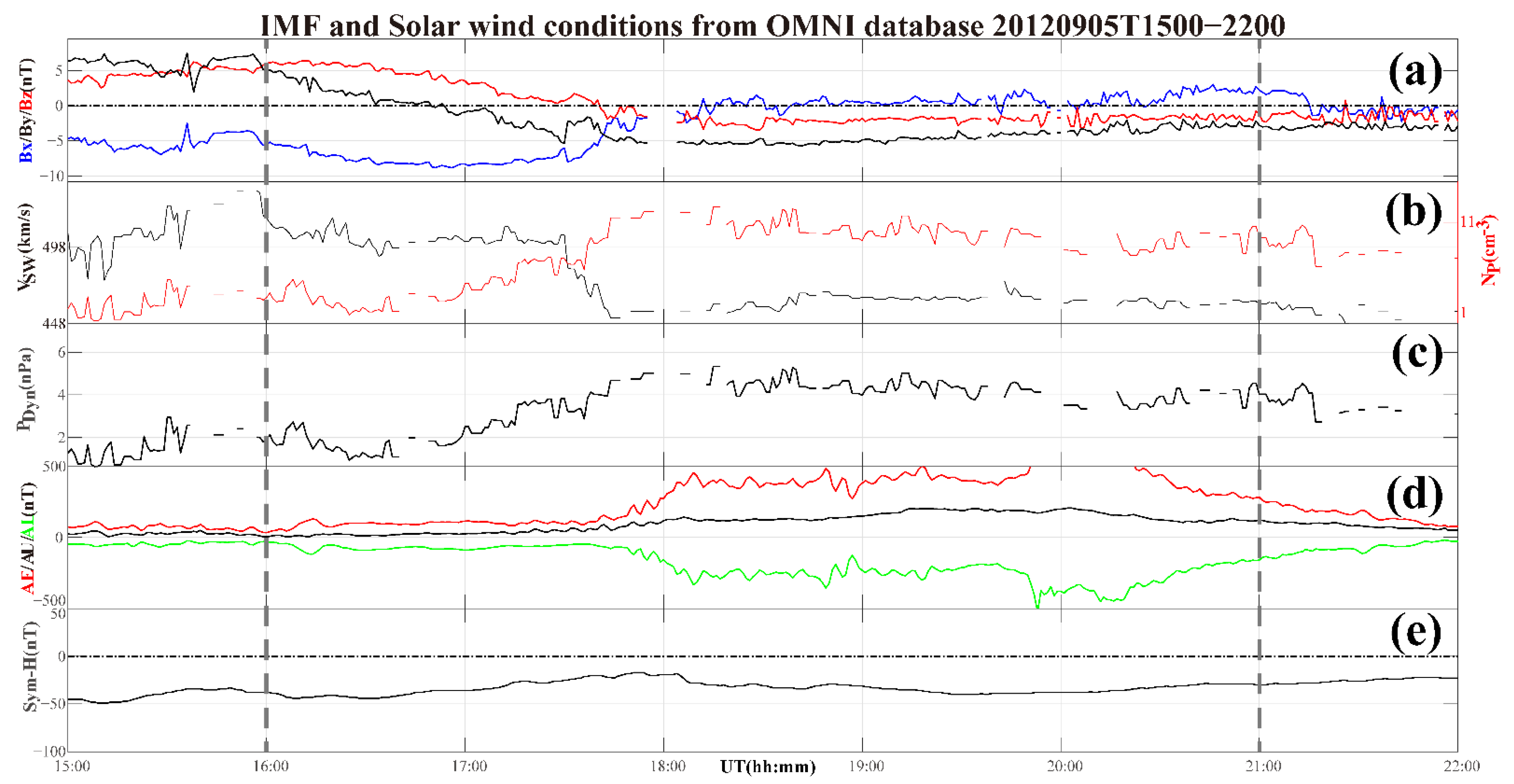
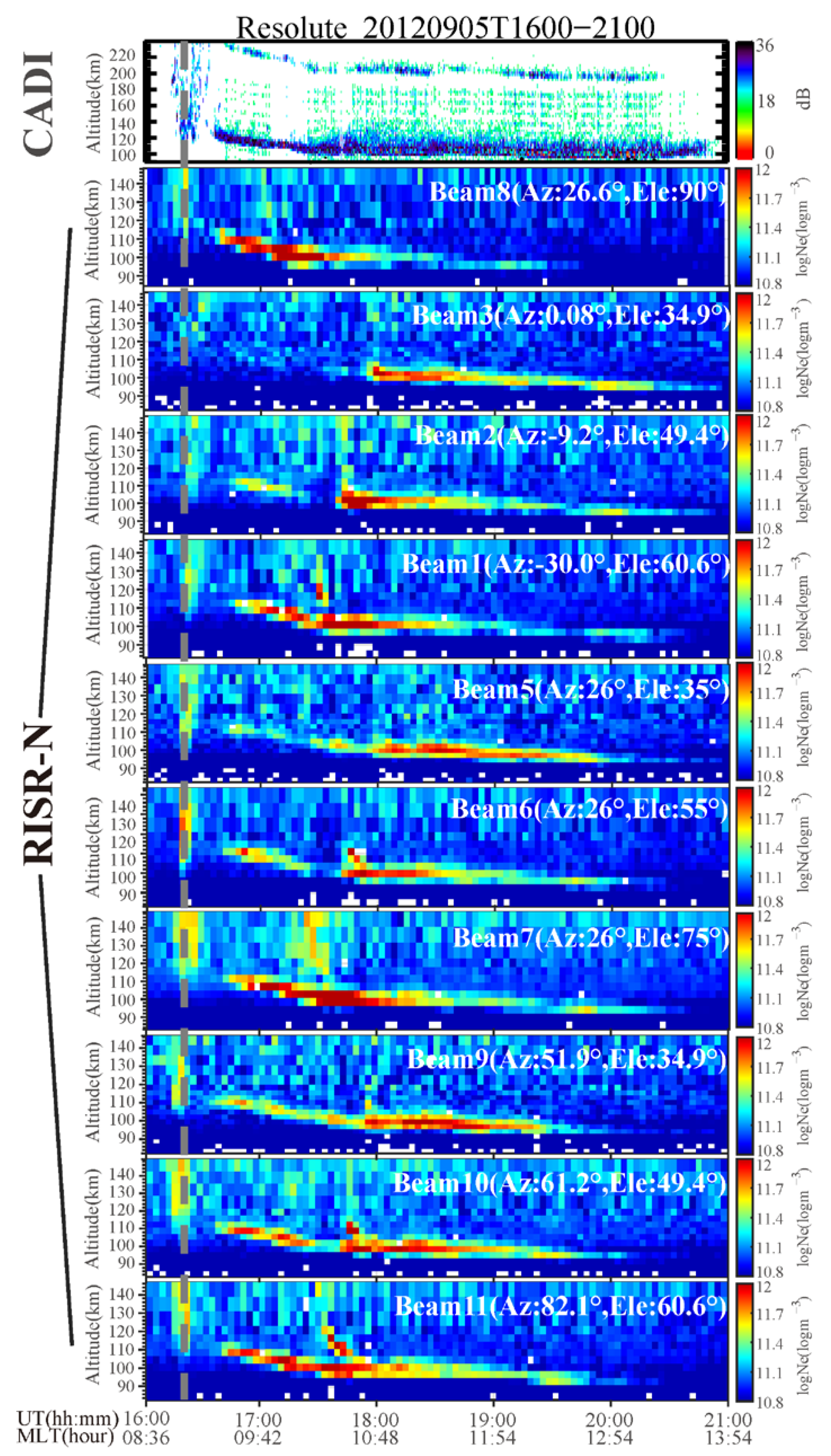

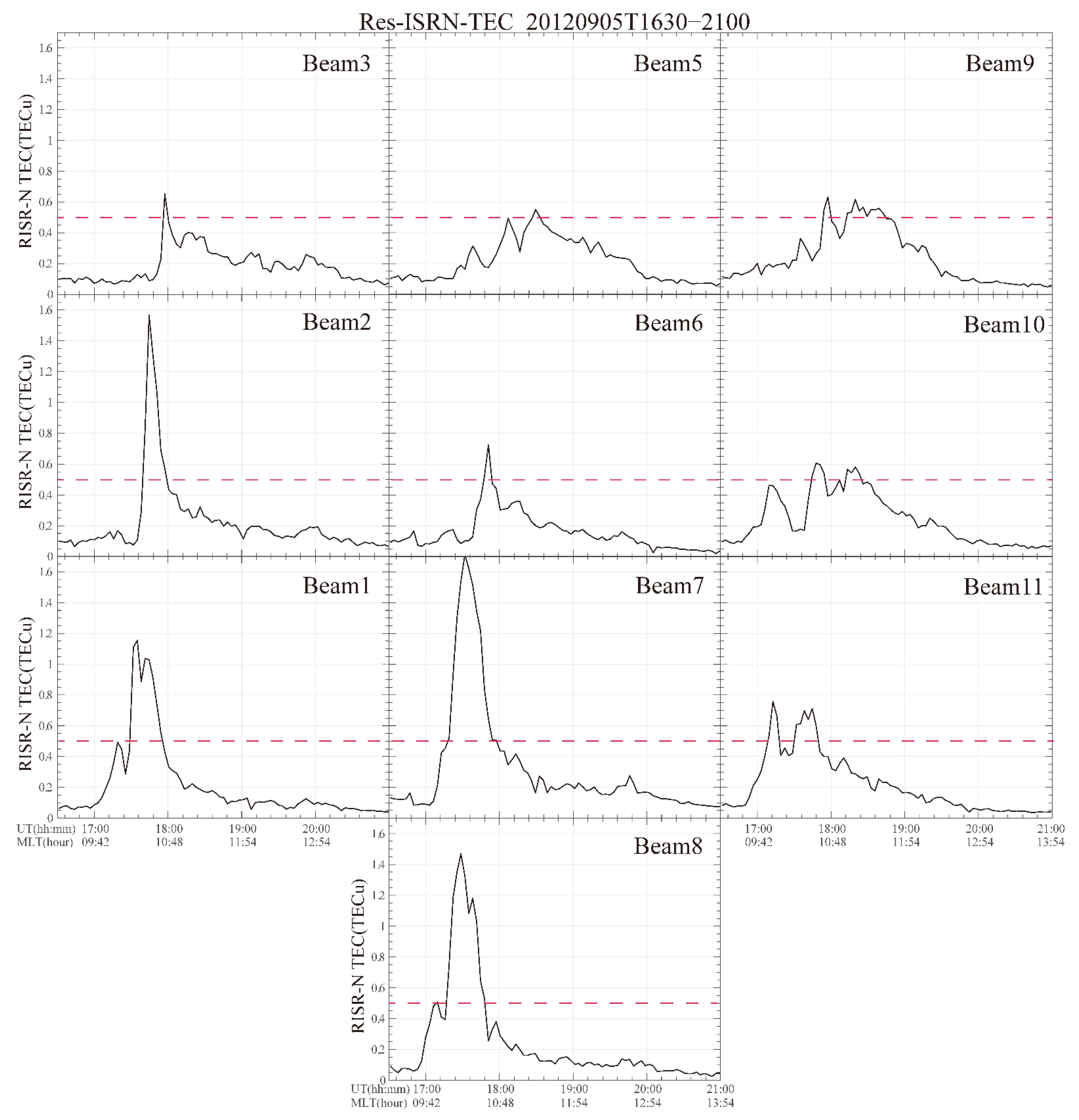
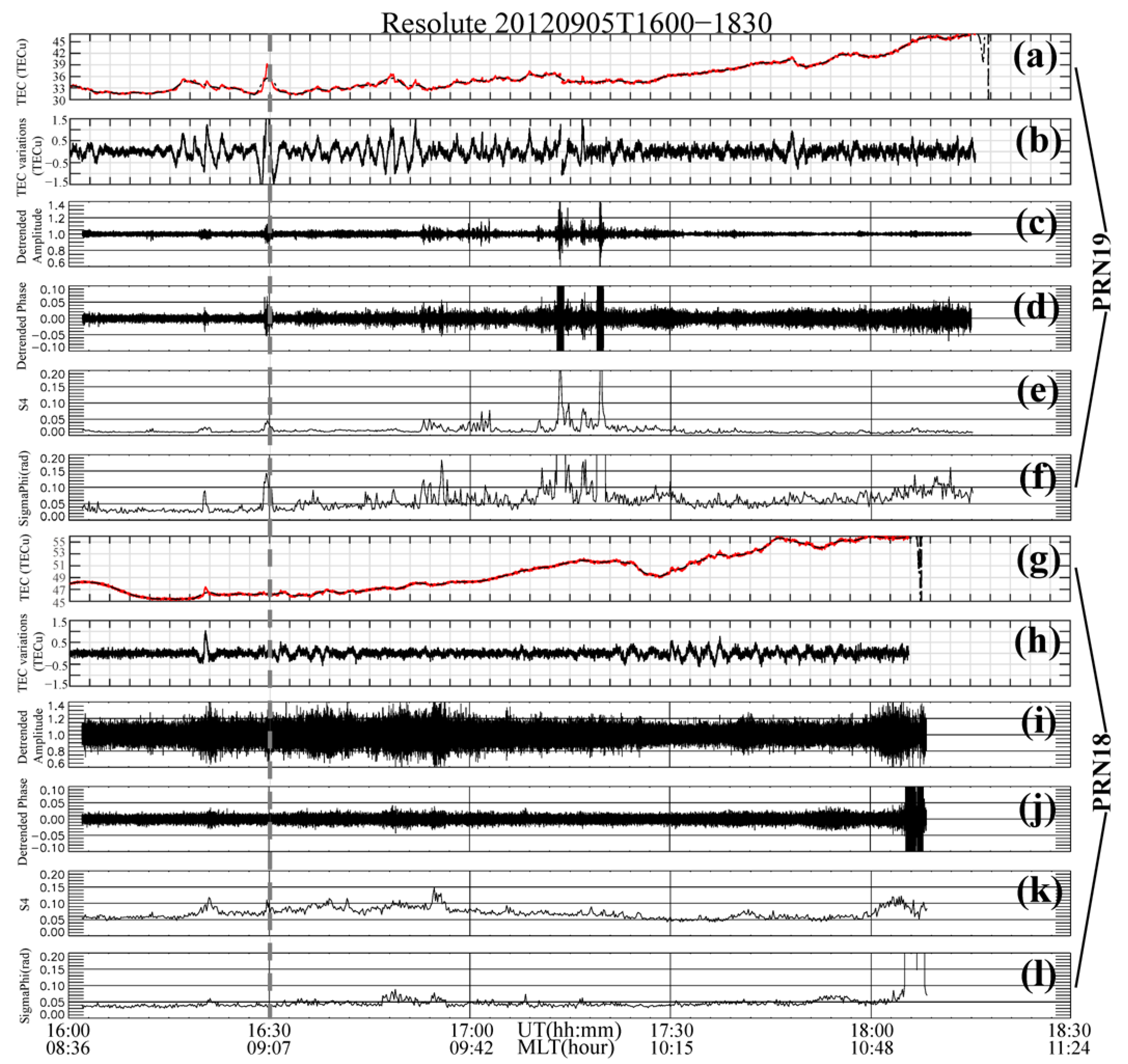
Publisher’s Note: MDPI stays neutral with regard to jurisdictional claims in published maps and institutional affiliations. |
© 2021 by the authors. Licensee MDPI, Basel, Switzerland. This article is an open access article distributed under the terms and conditions of the Creative Commons Attribution (CC BY) license (https://creativecommons.org/licenses/by/4.0/).
Share and Cite
Wang, Y.; Jayachandran, P.T.; Themens, D.R.; McCaffrey, A.M.; Zhang, Q.-H.; David, S.; Chadwick, R. A Case Study of Polar Cap Sporadic-E Layer Associated with TEC Variations. Remote Sens. 2021, 13, 1324. https://doi.org/10.3390/rs13071324
Wang Y, Jayachandran PT, Themens DR, McCaffrey AM, Zhang Q-H, David S, Chadwick R. A Case Study of Polar Cap Sporadic-E Layer Associated with TEC Variations. Remote Sensing. 2021; 13(7):1324. https://doi.org/10.3390/rs13071324
Chicago/Turabian StyleWang, Yong, Periyadan T. Jayachandran, David R. Themens, Anthony M. McCaffrey, Qing-He Zhang, Shiva David, and Richard Chadwick. 2021. "A Case Study of Polar Cap Sporadic-E Layer Associated with TEC Variations" Remote Sensing 13, no. 7: 1324. https://doi.org/10.3390/rs13071324
APA StyleWang, Y., Jayachandran, P. T., Themens, D. R., McCaffrey, A. M., Zhang, Q.-H., David, S., & Chadwick, R. (2021). A Case Study of Polar Cap Sporadic-E Layer Associated with TEC Variations. Remote Sensing, 13(7), 1324. https://doi.org/10.3390/rs13071324





